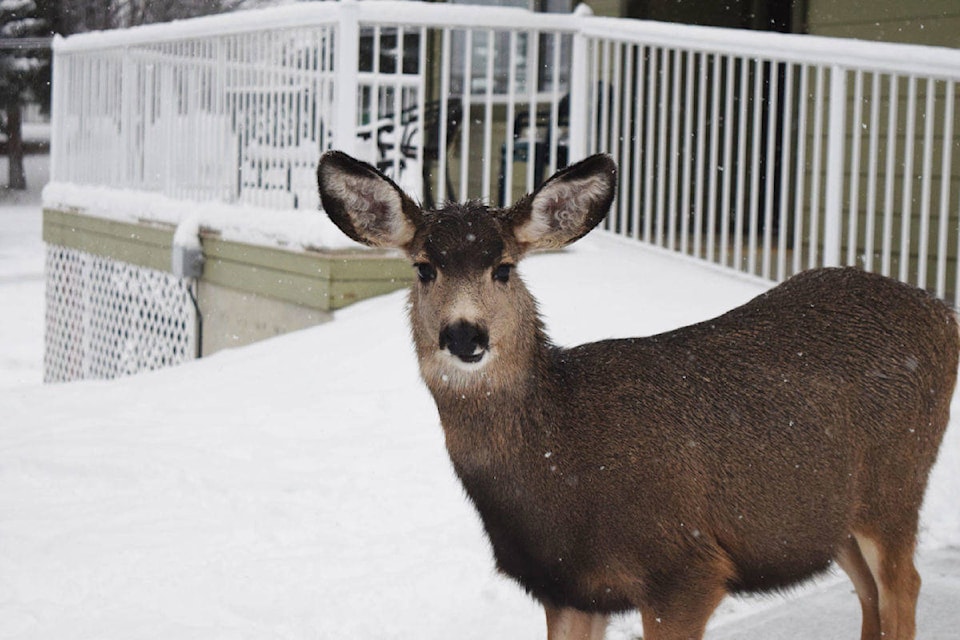Kimberley’s annual urban deer count has come and gone, and is presenting a picture of a fairly stable mule deer population within the city.
This year there were 69 mule deer counted, down a bit from 77 the previous year.
The countdown broke out as follows:
Townsite - 5
Downtown/Morrison/Upper Blarchmont - 9
Ski Hill/Trickle - 6
Lower Blarchmont - 7
Chapman/Rotary - 12
N. Marysville - 12
S. Marysville - 12
Of the 69 deer counted, there were 28 does, 28 fawns and 12 bucks, and one unclassified.
A spokesperson for the Ministry of Forests, Lands, Natural Resource Operations and Rural Development, provided the following information
“We use the same method annually. At this time, the trend indicates the population is stable. The counts are conducted by knowledgeable volunteers, usually during November or December while snow is on the ground. This helps to improve observability. Since 2011, almost 200 deer have been removed from Kimberley, which has reduced the number of deer within the town. Through these efforts, along with the creation and amendments to City bylaws, and continued public education, we hope to maintain the number of urban deer to be more manageable.”
Those deer have been removed in different ways, some by lethal cull, and then, as the city fought to find non-lethal methods to deal with the population, through translocation.
This year, Council has decided not to remove any animals. With the count only 77 last year, it was decided that was below the threshold of 125 animals, set as a guideline in the Managing for the Future document, established by the Kimberley Urban Deer Committee.
READ: No deer to be translocated from Kimberley this year
READ: Cranbrook council approves urban deer cull
There is also concern from the Ministry this year because of Chronic Wasting Disease being detected near Libby, Montana.
“Chronic wasting disease has not been detected in B.C.,” said the Ministry spokesperson. “Due to BC’s proximity to Libby, Montana - where CWD has been detected in about 50 animals - the BC Wildlife Health Program, along with the CWD team and other partners, have increased surveillance for CWD in the Kootenay Region. To date, over 1,000 deer, elk and moose from the Kootenay region have been tested for CWD. All tests were negative for the disease.
“CWD continues to spread within near-by jurisdictions, including Alberta and Montana; BC has been diligent in keeping the province free from CWD. Continued surveillance is critical to maintain confidence in a healthy wildlife resource and to ensure early detection.
“Minimizing risks of introduction and spread are imperative, therefore activities such as translocations will not be approved in the Kootenay region as this presents a risk that is too high for wildlife populations.”
The Ministry suggests the following ways to protect BC wildlife from CWD
◦ Increase awareness and understanding of the disease
◦ Prevent the import of carcasses that in the deer family (including deer, elk, moose and caribou), as well as other high-risk materials into BC
◦ Submit animals for testing to ensure early detection before the disease establishes in wildlife
◦ Be part of the solution – join the collaborative CWD effort
• More information is available online at: www.gov.bc.ca/chronicwastingdisease
During the deer count, volunteers also counted seven elk (on Teck lands near the transfer stations) and 65 wild turkeys in Chapman Camp.
There is no worry the elk would be moving into Kimberley, the spokesperson said. “ • The elk population is stable to decreasing. We do not anticipate that they will be moving in to Kimberley.”
carolyn.grant@kimberleybulletin.com
Like us on Facebook and follow us on Twitter
